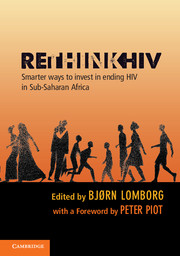Book contents
- Frontmatter
- Contents
- Figures
- Tables
- Contributors
- Acknowledgements
- Abbreviations and acronyms
- Foreword
- Introduction
- Part I The research
- 1 Sexual transmission of HIV
- 2 Prevention of non-sexual transmission of HIV
- 3 Treatment
- 4 Strengthening health systems
- 5 Social policy
- 6 Vaccine research and development
- Part II Ranking the opportunities
- Index
- References
3 - Treatment
Assessment paper
Published online by Cambridge University Press: 05 November 2012
- Frontmatter
- Contents
- Figures
- Tables
- Contributors
- Acknowledgements
- Abbreviations and acronyms
- Foreword
- Introduction
- Part I The research
- 1 Sexual transmission of HIV
- 2 Prevention of non-sexual transmission of HIV
- 3 Treatment
- 4 Strengthening health systems
- 5 Social policy
- 6 Vaccine research and development
- Part II Ranking the opportunities
- Index
- References
Summary
Anti-retroviral treatment has changed the nature of the HIV pandemic and has been a major driver of an increase in resources devoted to health care in low-income countries (Walensky and Kuritzkes 2010), but there are questions about whether treatment has been adequately expanded, and about how to maintain the gains that have been achieved (Bertozzi, Martz et al. 2009). The global pandemic of human immunodeficiency virus (HIV) and the associated acquired immune deficiency syndrome (AIDS), emerging in 1981, was initially characterized by an exceptionally high fatality rate, where almost everyone infected would die, after a long and variable incubation period (Hendriks, Medley et al. 1993). Successful combination treatment, which uses three drugs to suppress the virus to levels where the immune system ceased to be damaged and where the virus could not easily evolve into a resistant genotype, dramatically changed the outcome of HIV infection, turning it into a manageable chronic disease (Palella, Delaney et al. 1998). However, this introduction of successful treatment in 1996 quickly highlighted the gross inequities in access to health care and treatments globally, with a declining mortality seen in North America and Western Europe that was not possible in lower income settings. A remarkable advocacy campaign led to reduced costs per person per year of anti-retroviral medication, along with increasing resources globally (UNAIDS 2009, 2010). The goal of universal access to anti-retrovirals was embraced by politicians at the Gleneagles summit in 2006, and again endorsed in June 2011 by the UN General Assembly (World Health Organization 2010). Currently there are over six million people on effective anti-retroviral treatment globally, a great tribute to the efforts of many (UNAIDS 2010). However, this is less than half of those in current “need” of treatment, and the growth in resources, which for nearly a decade was 28 percent per year, has ceased. Would more resources be a good investment to stop deaths from HIV and stop the spread of HIV? In what follows, we model the spread of HIV, the impact of anti-retroviral treatment, and show how the trade-offs necessary in decisions about who to treat and how to treat them influence the benefits derived from treatment programs.
- Type
- Chapter
- Information
- RethinkHIVSmarter Ways to Invest in Ending HIV in Sub-Saharan Africa, pp. 125 - 182Publisher: Cambridge University PressPrint publication year: 2012
References
- 2
- Cited by

